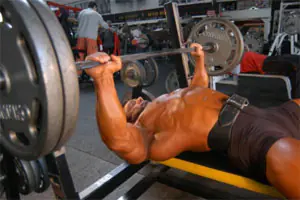Pressing exercises are specially auxiliary for developing the strength of the arm muscles, as well as the entire upper shoulder girdle, which is actively involved in pushing the projectile from the chest and fixing it in both the snatch and the jerk.
In triathlon, when the bench press was one of the key competitive movements, the speed of the bar in the chest push among the world's leading athletes was approximately 0.2-0.25 m/s higher than at the present time among biathletes. For this reason, to more successfully perform the push, it is necessary to use training pressing movements, and, of course, strength exercises for the triceps.
Of the large number of pressing exercises, the most commonly included in training are:
- standing press (from the chest and behind the head) with a normal, narrow and wide grip;
- bench press (horizontally and obliquely) with various grips;
- seated press (from the chest and behind the head).
The volume of strength exercises on the triceps (both in the off-season and in the competitive period) for junior athletes averages 10% of the total monthly load; Moreover, a large share of them (approximately 70%) should be performed exclusively on the overhead press, with a snatch grip, and the rest - on the bench press with a push grip.
For qualified athletes, the share of bench press exercises in the total volume of monthly training loads can be quite varied. The arsenal of bench press exercises used in training is also diverse:
- some athletes use both seated and standing presses and bench presses;
- others use only part of the first exercises;
- still others do not use pressing exercises at all.
The nature of bench press exercises and their number in training depend on individual characteristics, as well as on the physical and technical preparedness of the weightlifter. In the case when the training includes strength exercises for the triceps from a lying position, their volume in a monthly training for athletes of various qualifications and weight categories can range from 50 to 150 or more lifts. The weight used in bench press training is 35-75% of the clean and jerk limit and is approximately:
- in the preparatory period - 49%,
- in competitive - 51%.
The weight of the barbell used in the seated and standing press is equal to 25-65% of the limit in the clean and jerk and is:
- in the preparatory period—on average 37%,
- in competitive - 40%.
In the preparatory period, the weight of the barbell in the sitting and standing press is approximately the same for athletes of all weight categories; at the competitive stage, the heavier the weight category, the higher it is.
Results in triceps strength exercises do not directly affect results in the snatch and clean and jerk (their influence is indirect), so there is no need to achieve maximum results in the military press or bench press. In addition, when lifting a heavy weight in a standing press, you can injure your lower back, because it experiences a large load (military press is performed with a slight tilt of the torso back).
Also, to achieve truly impressive results, do not forget about proper sports nutrition. We recommend adding BCAA, gainers and protein shakes to your diet. Remember: without the proper amount of protein entering the body, you will not see high-quality muscles, and therefore an increase in strength, and, accordingly, new records in working on iron...
The number of repetitions of bench press exercises depends on the weight of the apparatus and is mainly 3-6 per approach. Athletes in heavy weight categories often increase the number of repetitions per set to 8.
In total, approximately 6-30 lifts are performed per workout for all kinds of presses. The number of repetitions depends mainly on the tasks and content of the training. For example, if a workout uses a chest push or a push jerk, then pressing exercises are not included in it or a small number of them are planned (6-18 lifts). When the above exercises are absent from training or used in small quantities, the number of strength exercises for the triceps and shoulder girdle increases.
This type of exercise should be used mainly in the middle or end of a workout, when a change in the working muscle groups is necessary.
Post Views: 111


